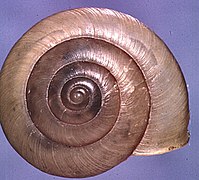Bradybaena similaris
| Asian trampsnail | |
|---|---|

| |
| Live Bradybaena similaris | |

| |
| Shell of Bradybaena similaris | |
| Scientific classification | |
| Domain: | Eukaryota |
| Kingdom: | Animalia |
| Phylum: | Mollusca |
| Class: | Gastropoda |
| Order: | Stylommatophora |
| Family: | Bradybaenidae |
| Genus: | Bradybaena |
| Species: | B. similaris
|
| Binomial name | |
| Bradybaena similaris | |
| Synonyms | |
|
Helix similaris Férussac, 1821 | |
Bradybaena similaris, the Asian trampsnail, is a species of small, invasive land snail. It is a pulmonate gastropod terrestrial mollusc in the family Bradybaenidae. It earned the common name based on its origins, and its habit of roosting on freight containers [citation needed]. This habit means that this may be one of the most broadly-distributed species of terrestrial snail in the world[citation needed]. Bradybaena similaris is the type species of the genus Bradybaena.
Distribution
[edit]This species is native to Southeast Asia, but it has been accidentally introduced to many areas around the world. The distribution includes:
The introduced distribution includes states on the Gulf of Mexico, and it is widespread in Florida, USA.[3] It has become widespread in Eastern Australia, usually living in association with exotic weeds. It can be found on Bermuda, Reunion island, Mayotte and Mauritius, New-Caledonia, Wallis and Futuna and French Polynesia.
Description
[edit]The width of the shell is about 12 to 16 mm with 5+1⁄2 whorls.[3] The color of the shell is light brown, often with a single, apical chestnut band.[3] The shell is sculptured with fine, irregular growth lines and fine spiral striae.[3] The lip of the adult shell is reflected and the columella is partially covering the umbilicus.[3]
-
An apical view of a brown shell
Food
[edit]The Asian trampsnail primarily consumes live plant matter, such as growing vegetables or plants like arugula. They are known for being destructive to gardens and crops because of their eating habits.[4][5] It has also been observed consuming coffee rust and the mycoparasite Lecanicillium lecanii.[6]
Ecology
[edit]As an introduced species, the Asian trampsnail is often found in areas with tall grasses and high humidity. Typically this species is found in gardens, greenhouses, and similar habitats, sometimes retreating under logs or fallen branches.[7]
This species is often common with abundant old shells on the ground and among leaf litter, as well as on vegetation and on trees.[3] It is active after rainfall.[3]
Dundee and Cancienne reported that this snail can survive winters in Louisiana where the temperature can fall as low as 5-10°C.[7]
It feeds on a wide variety of plants including citrus[3] and is considered as pest in agriculture.[3] This snail is often exported by accident from Florida to other areas and thus poses a quarantine problem for Florida.[3]
This species of snail creates and uses love darts during mating. Snail eggs generally take 2-4 weeks to hatch, lifespan 2-3 years.
References
[edit]This article incorporates public domain text, a public domain work of the United States Government from the reference.[3]
- ^ Férussac A. E. J. P. J. F. d'Audebard de [1821-1822]. Tableaux systématiques des animaux mollusques classés en familles naturelles, dans lesquels on a établi la concordance de tous les systèmes; suivis d'un prodrome général pour tous les mollusques terrestres ou fluviatiles, vivants ou fossiles. pp. j-xlvij [= 1-47], [1], 1-27, 1-110, [1]. Paris, Londres. (Bertrand, Sowerby).
- ^ Wu S.-P., Hwang C.-C., Huang H.-M., Chang H.-W., Lin Y.-S. & Lee P.-F. (2007). "Land Molluscan Fauna of the Dongsha Island with Twenty New Recorded Species". Taiwania 52(2): 145-151. PDF Archived 2011-07-18 at the Wayback Machine.
- ^ a b c d e f g h i j k
 Stange L. A. (created September 2004, updated March 2006). "Snails and Slugs of Regulatory Significance to Florida" Archived 2010-12-02 at the Wayback Machine. Division of Plant Industry, Florida Department of Agriculture and Consumer Services. accessed 27 August 2010.
Stange L. A. (created September 2004, updated March 2006). "Snails and Slugs of Regulatory Significance to Florida" Archived 2010-12-02 at the Wayback Machine. Division of Plant Industry, Florida Department of Agriculture and Consumer Services. accessed 27 August 2010.
- ^ "details". www.tsusinvasives.org.
- ^ "Bradybaena similaris". molluskman.
- ^ Hajian-Forooshani, Zachary; Vandermeer, John; Perfecto, Ivette (28 February 2020). "Insights from excrement: invasive gastropods shift diet to consume the coffee leaf rust and its mycoparasite". Ecology. 101 (5): e02966. Bibcode:2020Ecol..101E2966H. doi:10.1002/ecy.2966. hdl:2027.42/154946. PMID 31930485.
- ^ a b "Asian Trampsnail, Gulf State Marine Fisheries Commission". Archived from the original on 2007-06-24. Retrieved 2007-09-29.
Further reading
[edit]- Almeida M. N. & Bessa E. C. A. (2001). "Estudo do crescimento e da reprodução de Bradybaena similaris (Mollusca, Xanthonychidae) em laboratório. [Growth and reproduction of Bradybaena similaris (Férussac) (Mollusca, Xanthonychidae) in laboratory conditions]". Revista Brasileira de Zoologia 18(4): 1115-1122. doi:10.1590/S0101-81752001000400010. PDF.
External links
[edit]- Bradybaena similaris on the UF / IFAS Featured Creatures Web site
![]() Media related to Bradybaena similaris at Wikimedia Commons
Media related to Bradybaena similaris at Wikimedia Commons


